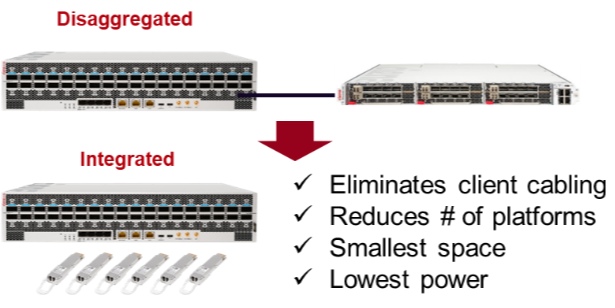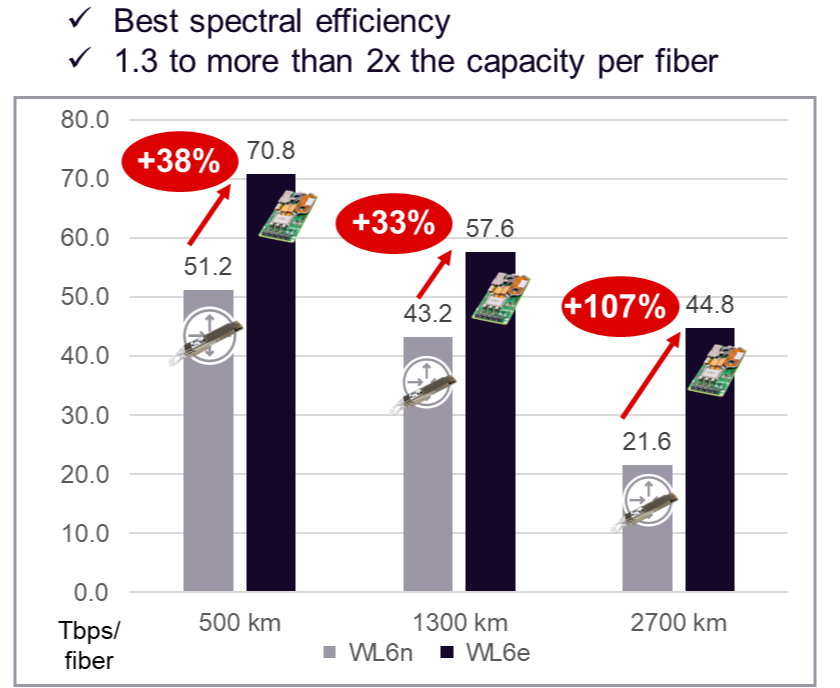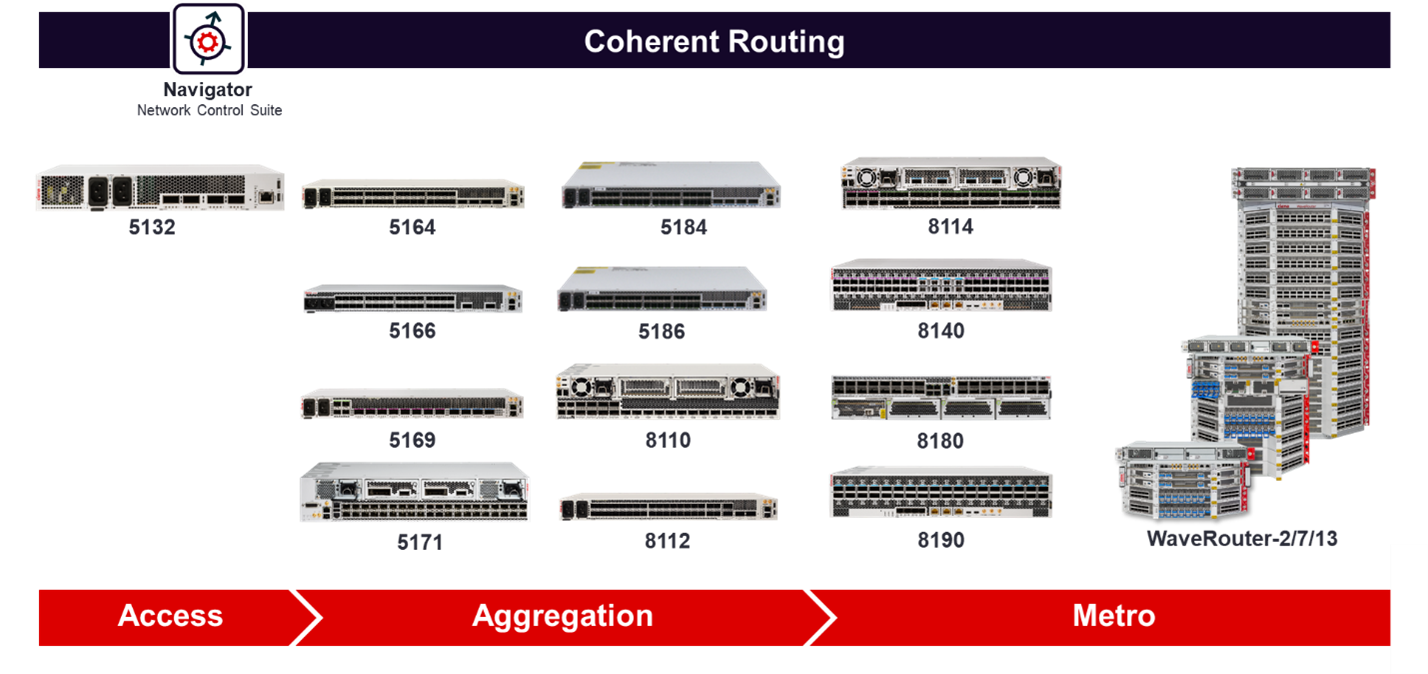Ciena’s Rafael Francis explains the innovations in its Coherent Routing solution, which are designed to optimize network operations to enable simple, scalable, and sustainable converged networking.
At Ciena, we have consistently said that when it came to IP/Optical convergence, a new approach was needed. This is why two years ago, we introduced Ciena’s Coherent Routing solution, which demonstrated our belief that convergence was not just about pluggable optics in routers.
More than just collapsing the IP and optical layers of the network, Ciena’s Coherent Routing takes a holistic approach, bringing together purpose-built routing, leading coherent optics, and intelligent, flexible photonics—all driven by a multi-layer network control suite that enables the visibility and insights you need to optimize network performance and service levels across a multi-layer, multi-vendor environment.
Over the past two years our Coherent Routing solution has seen significant market adoption, validated by more than 130 successful deployments. And as we have worked with our customers—we have learned from them and their convergence needs as well. The result? We are bringing new innovations to market to chart a course to lower costs and build simple, scalable, and sustainable converged networks.

Figure 1: Ciena’s Coherent Routing
Let’s look at all the work our teams have been doing to bring new capabilities to market and provide network operators with the ultimate choice in converged networking to cost-effectively and sustainably satisfy network requirements.
The benefits of coherent plugs in our routers for a cost-optimized solution
The availability of cost and performance optimized coherent optics comes at a pivotal time—as metro networks need to evolve and optimize as cloud and AI-driven demand bring forth a new era of networking.
Ciena's WaveLogic 5 Nano (WL5n 100/200/400G) and WaveLogic 6 Nano (WL6n 800G) plugs, when integrated into Ciena coherent routers, provide a flexible and cost-optimized solution for network operators' future growth. These plugs optimize transport infrastructure, minimize costs, and simplify deployment by integrating transponder and muxponder functionality into a single compact form factor versus having two separate platforms. This integrated approach reduces costs by ~25% and power by ~60% for the coherent DWDM portion of the solution compared to a disaggregated approach.
Leveraging Ciena's leading coherent optics technology, we enable high-capacity transmission over existing fiber infrastructure without the need for costly upgrades. With flexible and programmable interfaces, operators can easily adapt to changing requirements and ensure cost-effective services with a streamlined network design.

Figure 2: Cost optimized coherent routing
The benefits of performance optimized WaveLogic 6 Extreme
Pluggables are beneficial for optimizing costs and power in many scenarios, but there are applications that demand greater capacity and reach. To address this, performance-optimized coherent optics with embedded modems are employed, maximizing network capacity and efficiency through advanced modulation schemes, signal processing, and error correction techniques. This enables the creation of high-performance, scalable, and cost-effective optical networks.
By leveraging the spectral efficiency of newly available and industry’s only 1.6 Tb/s solution, WaveLogic 6 Extreme (WL6e), network operators can increase data capacity without the need for additional fiber installations, resulting in cost savings and improved return on investment (ROI).
WL6e's enhanced spectral efficiency allows for a capacity increase of 1.3-2x per fiber compared to plugs, making it a more scalable solution for longer-reach applications. While optimizing performance and spectrum usage, operators can reduce overall power consumption and minimize environmental impact, as dedicated transponder/muxponder units are still not required even for these high-performance applications.

Figure 3: Highest capacity per fiber
However, it is important to note that an integrated coherent plug or embedded modem alone is not sufficient without a purpose-built coherent router, intelligent photonic underlay, and coordinated multi-layer control software that complements its capabilities.
Let me explain the advantages of converging these three components and the value they bring to network infrastructure.
Purpose-built coherent routers facilitate the adoption of optical innovations
Most routers in deployment today were not designed with the integration of coherent WDM in mind. In contrast, purpose-built coherent routers are specifically designed with adequate cooling and thermal density to support coherent plugs in all ports. These routers also incorporate new optical innovations in a flexible and modular manner.
Due to the rapid lifecycle of DWDM technologies, routers need to be designed with considerations for integrating these advancements. Ciena's coherent routing family, including the 51xx, 81xx series and our most recent routers, the WaveRouter family, feature modular slots to accommodate emerging optical innovations in the market.

Figure 4: Ciena's coherent routing family
It is important to acknowledge that DWDM technologies have a more rapid life cycle than the typical deployment timeframe of a router in networks, as shown in the figure below. Therefore, design considerations are required in routers to incorporate these new technologies. It can’t be an afterthought.

Figure 5: DWDM transceiver life cycle was much shorter than other layers
For example, WaveRouter-2, WaveRouter-7, and WaveRouter-13, were designed from the ground up with convergence in mind and offer support for pluggable cost-optimized and performance-optimized coherent optics.

Figure 6: Pluggable cost optimized and performance optimized coherent routing
By integrating our industry-leading WaveLogic coherent modems, WaveRouter strikes the right balance between performance and sustainability. Combining routing and coherent DWDM functions into a single unit, WaveRouter eliminates the need for separate transponders/muxponders. This reduction not only lowers equipment manufacturing but also decreases e-waste, while the power and space savings contribute to a lower total cost of ownership, reducing both CAPEX and OPEX spend.
Intelligent photonic underlay
Where does that leave the intelligent photonic underlay? It is undeniable, integrated coherent optics in purpose-built coherent routers have advantages. Additionally, an intelligent optical ROADM foundation, such as with Ciena’s 6500 Reconfigurable Line System (RLS), underpins the flexible, programmable connectivity needed in today’s networks and is crucial in many coherent routing use cases.
Why? We believe there is no one-size-fits-all approach to coherent routing. The network needs to be able to scale for years to come, handle new and legacy traffic flows, extend to new locations, and easily evolve to next-gen Ethernet rates and coherent technologies—all while keeping power usage in check.
These are the benefits customers have been realizing from their ROADM networks over the past 15 years and expect, and need, to retain in converged networks moving forward. From a sustainability perspective alone, studies show that as networks fill with capacity, a flexible photonic underlay using ROADM provides 30-50% power savings compared to a purely hop-by-hop routed architecture and is necessary for some use cases.
Coordinated multi-layer control has gotten even better
The final crucial component is the coordinated multi-layer control software, empowering Coherent Routing to lead and control any network. Navigator Network Control Suite (Navigator NCS) provides a single point of control across multi-layer network infrastructure, enabling coordinated, simplified, and automated operations across the full lifecycle—planning, configuration, provisioning, monitoring, and assurance.
Multi-layer visualization is founded on Navigator’s holistic information model which correlates IP and optical layer constructs. With clear visibility of IP services and routers, alongside underlay photonic services, workflows between IP and optical network operations teams can be greatly accelerated.

Figure 7: With multi-layer visualization, alarms at any layer can be quickly diagnosed
What is new with Navigator NCS? Lots, for example we’ve introduced a valuable new feature that prevents IP traffic loss during planned optical maintenance. When an operator wants to do OMS or OTS disruptive maintenance, the software automatically identifies impacted photonic services and overlay IP links and moves the IP traffic to an alternative route. Another enhancement is in the area of network resiliency, whereby optical shared risk link groups (SRLGs)—when links share the same card, cable, or conduit—are auto-discovered and used for IP traffic engineering. This is much more accurate than retrieving stale fiber records from another system.
Planning also benefits from multi-layer coordination. Traditionally, capacity planning is a time-consuming and suboptimal process due to limited cross-layer visibility. Our novel approach is to optimally place IP traffic demands over the photonic layer so that maximum diversity, minimum latency, and maximum spectral efficiency are maintained and yet operator capital expenditure is reduced.
Is it time for you to put Ciena’s Coherent Routing in the driver’s seat?
Convergence is a force that cannot be ignored, and the advancements in performance-optimized optics, coherent routers, programmable photonics and coordinated multi-layer control are equally hard to overlook. If you are prepared to construct a network that is simple, scalable, and sustainable, we invite you to reach out to us. We would be delighted to collaborate with you on a proof of concept, allowing you to experience a test drive of Ciena’s Coherent Routing firsthand.






